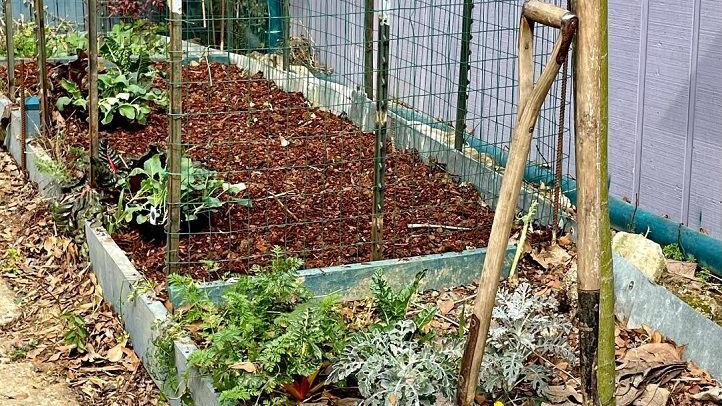
What’s the easiest DIY veg and herb garden for newbies?
In the past year as I walk my neighborhood, I’ve seen so many new gardeners giving it a go, often right out front as a proclamation: “We’re here, and we’re trying.”
Luckily, a lot of the timid newbies were mostly successful, which is great; it’s no fun learning to expect and power through the pitfalls of growing stuff, dealing with bugs, blights, inclement weather, and animals. But we stick with it, try figuring out what went awry, then with a sigh rework dirt and replant.
To me, a busy/lazy older guy with an aversion to excess effort, it’s a no-brainer to just plant stuff in regular flower beds in front of shrubs, and in big containers, using veggies and herbs like ornamental flowers. Or step it up and make small but efficient raised beds, with or without rigid sides. One neighbor simply covered rectangles of lawn with cardboard and leaves, and planted right through that. And it worked.
Beds and containers are easier and more productive in small spaces than long, skinny rows; I plant two or more compatible crops atop double-wide beds, mulch with leaves or bark, and when something is harvested I dig in the old mulch and cover with fresh mulch, then plant when I get around to it. You can even have multi-level raised beds, or put pots in the middles.
Occasionally for a new area I rent or borrow a big tiller for half a day, which is far less expensive than owning, with no worries about storage or keeping it in running condition. Had I a bigger garden I would probably get a little lightweight cultivator tiller, but because my beds are so compact area I can work them a bit at a time fairly easily, using time-tested tools – a shovel or spade, turning fork, hand trowel, and rake – for which I am the only moving part.
A lot of folks enclose raised beds, but all you really need to do is slope and firm or even plant flowers around the sides. To keep things neat and less muddy between beds use mulch, old carpet samples or a wide board.
Rather than fill beds with store-bought soil, I recommend digging your native dirt a few inches deep then add stuff to it, like crumbled crackers in a bowl of chili. It’s cheaper and works better than all one or the other.
Last month I added a fence because a soft-hearted neighbor puts out cat food for raccoons and ‘possums, which later use my garden for after dinner mints; roaming cats also treat my fresh soil as their litter box. Yuck. I also drape insect netting over my cabbage, kale, broccoli, and cauliflower to foil caterpillar-causing moths; in the summer I cover my squash as well, raising it only to hand pollinate and harvest as needed.
There’s nothing sweeter than having little flowers around the edges, partly for looks and partly to attract more pollinators. My favorites include compact zinnias, but I also tuck lantana, blue salvias, and other long-flowering bee- and butterfly-friendly somethings here and there as well.
So it’s a regular year-round thing, growing stuff every which way whenever the mood strikes and the weather is right, digging in old mulch then planting whatever is suitable for the season, adding fresh mulch, watering as needed, harvesting, and repeating whenever I get around to it.
Meanwhile, to keep things cheery, I’m painting pots and raised beds, and adding a simple scarecrow and birdhouse. If nothing grows, I’ll still have something to smile about.
The Link LonkFebruary 14, 2021 at 04:00PM
https://ift.tt/3ahEd28
FELDER RUSHING: Veggie, herb gardens don't have to be complicated - Northeast Mississippi Daily Journal
https://ift.tt/3eCf9lu
Herb
No comments:
Post a Comment